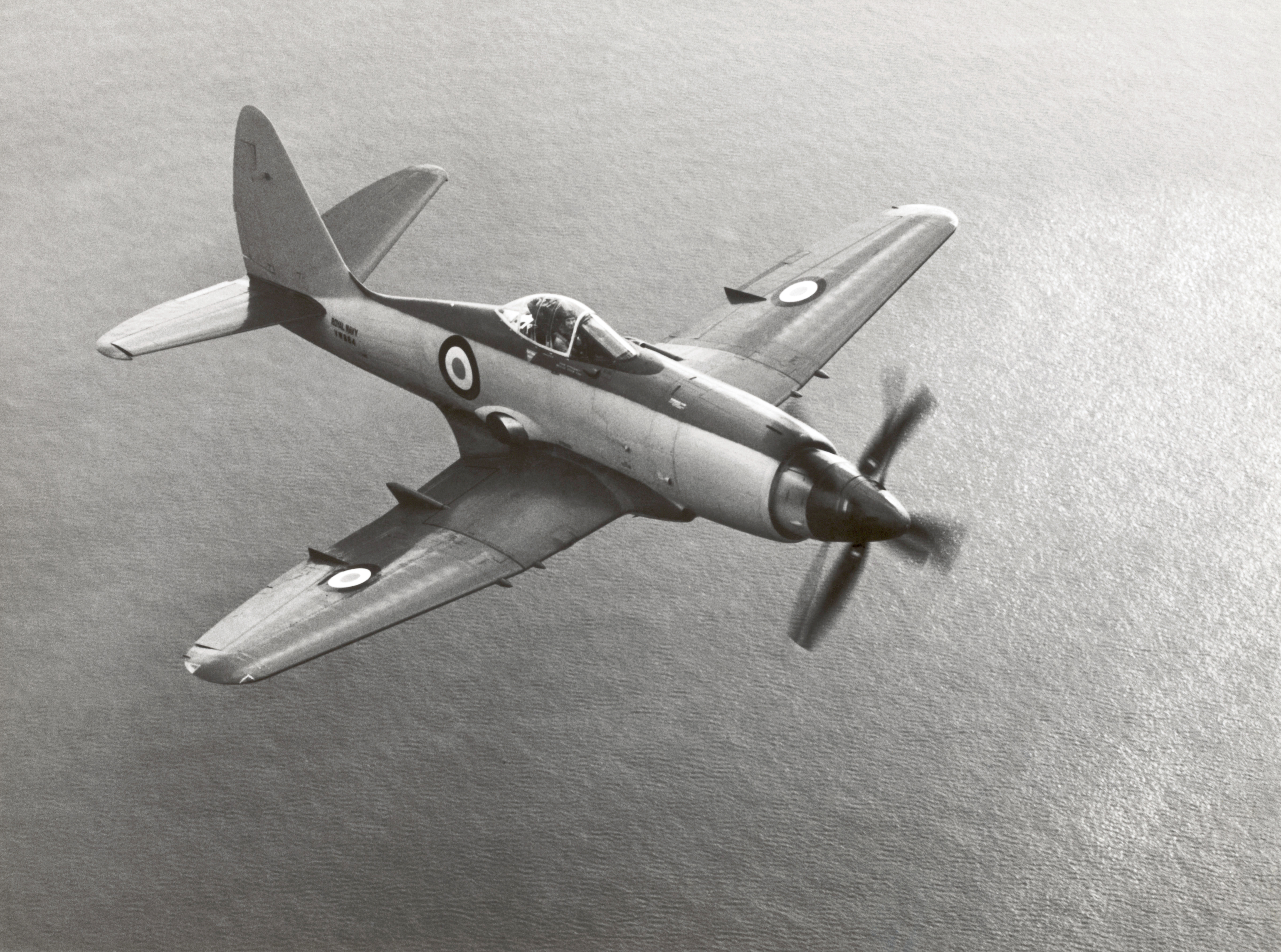Can you identify this carrier-based turboprop? (click the arrow for the answer)
Westland Wyvern
Named after a legendary Anglo-French dragon with two legs and two wings, the Westland Wyvern was conceived as an aircraft carrier–based strike fighter for Britain’s Fleet Air Arm. It earned several distinctions in the long course of its development, but that very protracted process occurred at a time of transition in aviation in which it went from potent to innovative to obsolete, all before its wheels first alighted on a carrier deck.
Designed by Westland’s chief engineer, Teddy Petter, to satisfy FAA specification F.13/44, Project P.10 began as a large fighter with folding wings and the pilot sitting in a raised cockpit that gave him outstanding visibility, powered by a 2,690-hp Rolls-Royce Eagle 22 piston engine. In addition to four 20mm Hispano cannons in the wings, it could carry bombs, up to eight rockets or a torpedo. Six prototypes were ordered (four for the FAA, two for the Royal Air Force) in November 1944 and on December 12, 1946, Harold Penrose took the first Wyvern TF Mark I skyward. During subsequent development, however, the Eagle was replaced with a Rolls-Royce Clyde, making it the first turboprop warplane in British service. That engine proved unreliable and the Wyvern TF Mark 2 switched to a somewhat improved Armstrong Siddeley Python. In June 1950 a Python-engine Wyvern landed aboard HMS Illustrious, the first turboprop aircraft to do so.
The Wyvern developed into a fair-handling airplane but was plagued with engine and other technical problems. In spite of that, the FAA was committed to production, which after the first aircraft’s arrival in service in 1953 came to a total of 127, serving in nine squadrons. In the course of their career, 68 Wyverns were wrecked in accidents and 13 pilots were killed.
The principal variant, the Wyvern S Mark 4, was powered by the 3,670-hp Python 3 turboprop engine. Wingspan was 44 feet, length 42 feet and height 15 feet. The Wyvern’s empty weight was 15,600 pounds and takeoff weight 24,500 pounds. Maximum speed was 381 mph, ceiling was 28,000 feet and range 910 miles.
Although for most of the Wyvern’s career just taking off and landing in one piece was challenging enough for its pilots, the airplane did get one fleeting chance to prove itself in battle. That came during Operation Musketeer, when Britain and France, reacting to Egyptian president Gamel Abdel Nasser nationalizing the Suez Canal, conspired with Israel to invade the country. Among the five British and two French carriers involved was HMS Eagle, whose deck lineup included the nine Wyverns of No. 830 Squadron, which carried out 79 strike missions between October 27 and November 7, 1956. On November 3 Lieutenant Dennis F. McCarthy’s Wyvern was hit by Egyptian anti-aircraft artillery, but after loosing his bombs and nursing his plane over the Mediterranean Sea, he ejected and was rescued 75 minutes later by a Westland Whirlwind helicopter. On November 5 Lt. Cmdr. William H. Cowling’s engine was hit by small-arms fire, but he managed to get out to sea within 20 miles of Eagle before having to eject and he too was rescued by helicopter. Amid the Wyvern’s “first” were two lasts: Cowling was the last FAA pilot and his mount the last FAA warplane to be brought down by enemy action.
While 830 Squadron’s Wyverns had acquitted themselves well in a campaign that would end up politically backfiring on Britain, France and Israel, it was somewhat worthy of note that they shared the sky with the 36 French Vought F4U-7 Corsairs operating from carriers Arromanches and La Fayette. A World War II design that had also seen action over Korea and Indochina, the Corsair had also done well during Musketeer, and in fact still outperformed the Wyvern in all respects. Also entering service on the British carriers were Hawker Sea Hawk jet fighters that sealed the Wyvern’s fate. It was retired from service in 1958.





